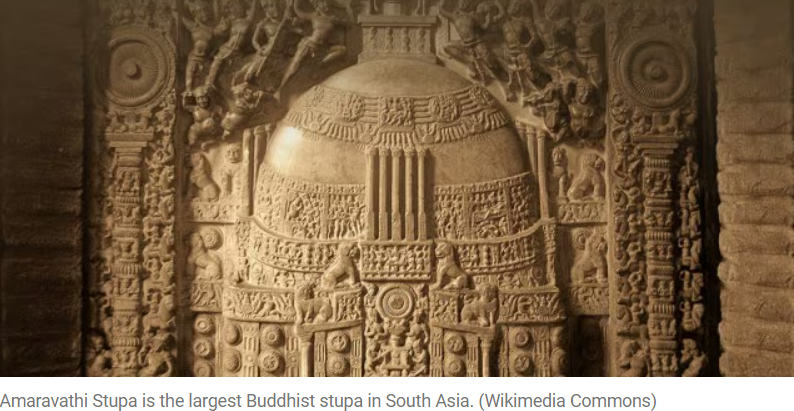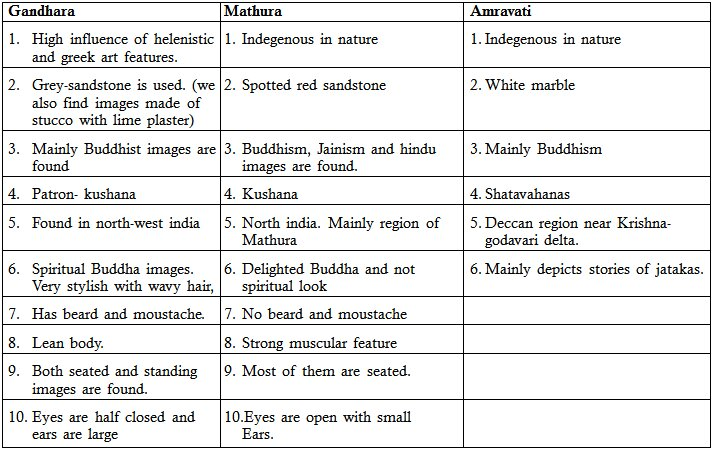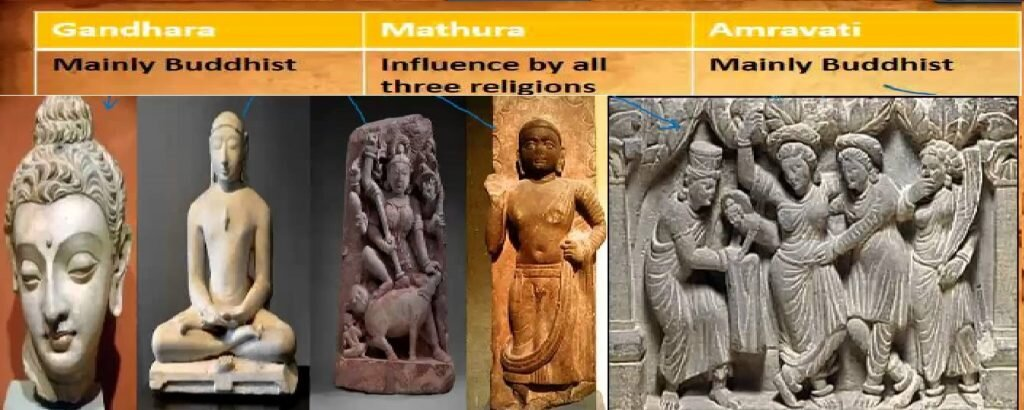Indian Heritage & Culture
Amravati as a Buddhist Site
- 25 Jul 2024
- 11 min read
For Prelims: Raja Vessareddy Nayudu, Amravati Stupa, Magadh, Emperor Ashoka, Buddhist council, Nagarjunakonda, Shaivism, Megalithic burials, Mahayana Buddhism, Acharya Nagarjuna, Amravati school of art
For Mains: Amravati School of Art, Indian Architecture
Why in News?
Recently, the Finance Minister announced Rs 15,000 crore in financial support for Andhra Pradesh to build its capital city, Amravati, and boost other development activities in the state.
- This has brought back focus on Amravati, a site of immense historical and spiritual significance in Andhra Pradesh that remains relatively unrecognised.
What are the Key Facts About Amravati and Andhra Buddhism?
- Historical Evolution:
- In the late 1700s, Raja Vessareddy Nayudu unknowingly discovered ancient limestone ruins in Andhra’s Dhanyakatakam village, which he and the locals used for construction, leading to the renaming of the village to Amravati.
- The systematic destruction of the ruins continued until 1816, when Colonel Colin Mackenzie's intensive survey, despite causing further damage, led to the rediscovery of the grand Amravati Stupa.
- In 2015, the Andhra Pradesh Chief Minister announced the new capital, Amaravati, inspired by the historic Buddhist site, aiming to develop it into a modern city akin to Singapore.
- Amravati and Andhra Buddhism:
- Buddhism, which emerged in the fifth century BCE in the ancient kingdom of Magadh (present-day Bihar), made its way to Andhra Pradesh mainly through trade routes in Andhra Pradesh.
- Buddhism was founded by Siddhartha Gautama, who attained enlightenment and became known as the Buddha.
- The first significant evidence of Buddhism in Andhra Pradesh dates back to the 3rd century BCE when Emperor Ashoka set up an inscription in the region, providing a major impetus to its spread.
- Monks from Andhra were present at the first Buddhist council held in 483 BCE at Rajgir, Bihar.
- Buddhism thrived in the region for nearly six centuries until the 3rd century CE, with isolated sites like Amravati, Nagarjunakonda, Jaggayapeta, Salihundam, and Sankaram continuing to practice the religion until the 14th century CE.
- Historians note that Buddhism's presence in Andhra coincided with its first urbanisation process, significantly aided by oceanic trade, which facilitated the religion's spread.
- Buddhism, which emerged in the fifth century BCE in the ancient kingdom of Magadh (present-day Bihar), made its way to Andhra Pradesh mainly through trade routes in Andhra Pradesh.
- Difference Between the Nature of Northern Buddhism and Andhra Buddhism:
- Merchant Patronage: In Andhra, merchants, craftsmen, and wandering monks played a crucial role in the spread of Buddhism, contrasting with the royal patronage (king Bimbisara or Ajatashatru) seen in North India.
- Influence on Political Rulers: Traders' success and their association with Buddhism influenced Andhra's political rulers, who issued inscriptions supporting the Buddhist sangha, suggesting a bottom-up spread of Buddhism.
- Integration of Local Practices: Buddhism in Andhra integrated local religious practices, such as megalithic burials, and Goddess and Naga (snake) worship, into its doctrines, reflecting a unique adaptation of Buddhism to regional traditions.
- Significance of Amravati in Buddhism:
- Amravati is renowned for being the birthplace of Mahayana Buddhism, one of the major branches of Buddhism that emphasizes the path of the Bodhisattva.
- Acharya Nagarjuna, a prominent Buddhist philosopher, lived in Amravati and developed the Madhyamika philosophy, focusing on the concept of emptiness and the middle way.
- From Amravati, Mahayana Buddhism spread across South Asia, China, Japan, Korea, and Southeast Asia..
- Factors Leading to the Decline of Buddhism in Andhra Pradesh:
- Rise of Shaivism: One of the primary factors contributing to the decline of Buddhism in Andhra Pradesh was the rise of Shaivism.
- By the seventh century CE, Chinese travellers noted the decline of Buddhist stupas and the thriving Shiva temples, which received patronage from aristocrats and royals.
- The growing influence of Shaivism offered a more structured and socially integrated religious framework that appealed to the local populace and rulers, drawing support away from Buddhist institutions.
- Decline of Urbanisation: During the third century BCE, the region experienced significant urbanisation and trade, which supported Buddhism's spread due to its emphasis on a casteless society.
- However, six centuries later, economic degradation led to a decline in patronage for Buddhist institutions.
- By the fourth century CE, Buddhist institutions found themselves without much patronage.
- Arrival of Islam: With the arrival of Islam, the Islamic rulers, who were generally more inclined towards supporting Islamic institutions, withdrew royal patronage from Buddhist establishments.
- Rise of Shaivism: One of the primary factors contributing to the decline of Buddhism in Andhra Pradesh was the rise of Shaivism.
What are the Key Features of the Amravati School of Art?
- About:
- During the post-Mauryan period, the Amravati school of art from the ancient Buddhist site of Amravati in Andhra Pradesh emerged as one of the three most significant styles of ancient Indian art, alongside the Mathura and Gandhara schools.
- Historical Context and Influences:
- Amravati Stupa:
- The Amravati Stupa, a grand Buddhist monument, was the centrepiece of the Amravati School of Art. This site became a hub of artistic and architectural activity, significantly contributing to the development of Buddhist art in India.
- In the early 19th century, government indifference to conserving ancient monuments led to local people and British officials using stupa materials for construction, causing further degradation.
- Excavations by officials like Walter Elliot in 1845 and the shipment of sculptures to Calcutta, London, and Madras also contributed to the site's decline.
- Amravati Stupa:
- Key Characteristics of Amravati School of Art:
- Major Centres: Amaravati and Nagarjunakonda.
- Patronage: This school was patronised by Satvahana rulers.
- Key Feature: Tribhanga posture, i.e. the body with three bends was used excessively by Amaravati school in its sculptures.
- The sculptures from Amravati are noted for their high aesthetic quality and intricate detailing, primarily crafted from palnad marble, a special kind of limestone that allows fine and intricate carvings.
- The art often features narrative panels depicting scenes from the life of the Buddha, Jataka tales, and various Buddhist rituals and practices.
- A particular depiction of the Buddha from Amravati, with the robe on the left shoulder and the other hand in abhaya (gesture of fearlessness), became iconic and was replicated in other parts of South and Southeast Asia.
- Unlike the Mathura and Gandhara schools, which show Graeco-Roman influences, the Amravati school developed a unique style with little external influence, emphasizing indigenous artistic traditions.
- Global Dispersion of Amravati Art:
- Today, sculptures from the Amravati Stupa are scattered across the world, with significant collections in the British Museum, the Art Institute of Chicago, Musee Guimet in Paris, and the Metropolitan Museum of Art in New York.
- Indian museums such as the Government Museum in Chennai and the National Museum in New Delhi also house pieces of Amravati art.
- Australia remains the only country to have returned a stolen Amravati-style sculpture.
- Difference Between Amravati, Mathura, and Gandhara Schools of Art:
|
Drishti Mains Question: Discuss the key features of the Amaravati school of art and analyse its significance in the context of ancient Indian art. |
UPSC Civil Services Examination, Previous Year Question (PYQ)
Prelims:
Q. Which one of the following statements is correct?(2021)
(a) Ajanta Caves lie in the gorge of Waghora river.
(b) Sanchi Stupa lies in the gorge of Chambal river.
(c) Pandu-lena Cave Shrines lie in the gorge of Narmada river.
(d) Amaravati Stupa lies in the gorge of Godavari river
Ans: (a)
Q. Which of the following kingdoms were associated with the life of the Buddha? (2015)
- Avanti
- Gandhara
- Kosala
- Magadha
Select the correct answer using the code given below:
(a) 1, 2 and 3
(b) 2 and 3 only
(c) 1, 3 and 4
(d) 3 and 4 only
Ans: (d)
Mains:
Q. Highlight the Central Asian and Greco-Bactrian elements in Gandhara art. (2019)
Q. Gandhara sculpture owed as much to the Romans as to the Greeks. Explain. (2014)







